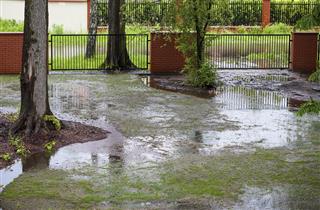
If you notice oak tree leaves turning brown and falling off, it is high time to correct the root cause of this problem. The probable reasons for this are lack of water, drainage issues, quality of soil, diseases, and pest infestation.
Oaks are valuable landscaping trees, which are also important for the production of high quality timber. More than 400 species of this genus are identified, out of which some are categorized as shrubs. Oak trees are also associated with several cultures across the world. The spectacular canopy shape, spiral arrangement of foliage, toothed leaf margins, and furrowed bark are its notable features. With any variety, learning more about the plantation and caring tips are essential to maintain healthy and disease free plants.
Similar to other yard tree species, oaks are susceptible to certain diseases and pests. Most of these diseases are observed at particular seasons, while some are present throughout the year. In the latter, faulty cultural practices and irregularities in the factors pertaining to soil science are the prime causes. One such issue is the brown coloration of an immature foliage. It is not unusual to notice oak tree leaves turning brown and eventually, falling off.
Brown coloration and abscission of mature oak leaves is a common phenomenon. But, if this occurs in a large number of young and tender leaves, then it is a problem that needs correction. If you are among one of those hobbyists who have come across such problems, then check out the following possible reasons, which will help you in identification of the causes and ways for correcting them:
Less Water
In a majority of tropical evergreen trees, the most common cause for leaves turning brown is the lack of water. Oaks (depending upon the cultivar) cannot tolerate a drought condition for a prolonged period, which afterward will develop brown coloration of the leaves, if the dry spells continue for a long duration.
Lack of Soil Nutrients
This problem is also common, when oaks are planted in poor soil. As long as you supplement the soil with essential plant nutrients, the trees will grow well. However, if you fail to add adequate fertilizers, then you will notice development of diseases and symptoms like curled leaves, leaf spots, and finally, the death of the tree.
Drainage Problem
Another possible reason is change in the drainage system of the soil. Availability of either too less water (drought) or too much water (water-logged soil) can cause leaf browning in the trees. This problem is obvious, if you spot foliage discoloration in trees that are planted near construction sites.
Leaf Diseases
Depending upon the disease, the leaves may develop unusual signs like spots and watery patches. Severe infestation by fungus (mildew and mold) can lead to yellowing, browning, and dropping of the leaves. If you come across any of the fungal infection signs, take advice from a horticulturist to solve the problem as soon as possible.
Insect Infestations
Heavy insect infestation can also lead to leaf spots and brown coloration. These insects bore through the wood and suck the sap, resulting in manifestation of certain disease signs. Check for the presence of insects in the stem, twigs, and branches and kill them by using appropriate insecticides.
Soil Microbes
Soil microbes are the worst cause. As we all are aware, there are several soil borne pathogens that have the potential to infect plants. Oak tree diseases caused by soil microbes are difficult to identify and treat.
Do not use pesticides and insecticides without knowing the root cause of the oak tree leaves turning brown. Or else, you will end up worsening the disease, rather than reducing it. The best way is to stick to the cultural practices for each season, as suggested by the horticulturists. By doing so, you can maintain favorable conditions required for their proper growth and prevent an onset of any disease.





